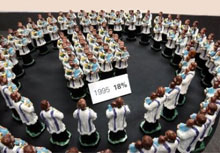 |
San Cayetano's statues,
Argentina's patron saint of work, are on display at the
opening of the Foreign Debt Museum in Buenos Aires, Argentina,
Thursday, April, 28, 2005. Sign near the statue indicates the
18 percent of unemployment in Argentina in 1995. (AP
Photo/Natacha Pisarenko)
| |
Three years after staging the largest debt default
in modern history, Argentina recently opened what may be the first Museum
of Foreign Debt to teach people the perils of borrowing
abroad.
The subject is heavy, but the museum's creators have tried to make the
mood light and the displays accessible to everyone, especially
schoolchildren.
In one corner, a pink, doll-size kitchen
represents the recipes of the
International Monetary Fund, which Argentines blame for encouraging the
heavy borrowing in the 1990s that led to the catastrophic economic
collapse in late 2001.
"We chose a play kitchen because we are always so innocent and believe
in magic recipes from abroad," said museum designer Eduardo Lopez. "Look,
we open the freezer and the oven and there is no food."
But the museum in the University of Buenos Aires
economics department doesn't dwell only on this latest debt crisis: It goes back to
Argentina's first default in the early 1800s and gives a detailed account
of the last 30 years when the country's foreign debt woes snowballed
.
Visitors can delve
into a spongy "black hole" -- the place where all
that borrowed money ended up.
"I liked best the black hole with everything the debt swallowed --
education, families, jobs," said Fabian Jader, 34, an opening night
visitor. "I feel anger and pity for the people, but above all
helplessness."
Argentina's economy has recovered at a healthy
clip in the last two years and the country is on the cusp
of ending its default of some $100
billion (52.4 billion pounds) in foreign debt.
But 40 percent of the population in the once-wealthy nation still lives
below the poverty line, many of them in the crime-ridden industrial rust
belt around Buenos Aires.
"People know absolutely nothing about how we accumulated all this debt,
they only know about the misery they have seen lately," said museum
director Simon Pristupin, who dreamed up the idea in 2001 and struggled to
convince skeptics.
"I think this museum is going to become very important, but right now
it's just a little bird."
Pristupin said his favourite part of the museum is a golden cart
sculpture made out of cardboard.
"It symbolizes Argentina's reality: everything's golden, but it's made
of cardboard and that reminds us of all those people who today collect
cardboard for recycling."
(Agencies) |
近日,阿根廷首個(gè)外債博物館正式對(duì)外開(kāi)放。三年前,阿根廷爆發(fā)了現(xiàn)代史上最大的外債違約,三年后的今天此舉旨在教育人們尋求海外貸款的危險(xiǎn)性。
雖然主題很沉重,但該館的創(chuàng)建者們力圖營(yíng)造出一個(gè)輕松的參觀氛圍,并且努力使每個(gè)參觀者,特別是還在上學(xué)的孩子們,能夠明白展覽的內(nèi)容。
展廳的一個(gè)角落擺放著一個(gè)粉紅色的玩具小廚房,它代表著國(guó)際貨幣基金組織的財(cái)政建議。阿根廷人指責(zé)這些建議鼓勵(lì)該國(guó)在90年代大量向外借債,從而導(dǎo)致了2001年末災(zāi)難性的經(jīng)濟(jì)崩潰。
“選擇這個(gè)玩具廚房是因?yàn)槲覀兛偸鞘痔煺娴南嘈艊?guó)外的神奇密訣。瞧,當(dāng)我們打開(kāi)冰箱和考箱時(shí),里面卻沒(méi)有食物。”該館的設(shè)計(jì)師愛(ài)德華多·洛佩斯說(shuō)。
這個(gè)位于布宜諾斯艾利斯大學(xué)經(jīng)濟(jì)系的博物館并不只限于最近發(fā)生的那次債務(wù)危機(jī),它還展示了發(fā)生在19世紀(jì)早期的阿根廷首次債務(wù)違約以及最近30年阿根廷外債瘋長(zhǎng)的詳細(xì)記錄。
參觀者還可以在一個(gè)有彈性的“黑洞”里摸索探尋,那個(gè)“黑洞”代表了海外貸款的最終流向。
“我最喜歡展出的那個(gè)黑洞,外債吞噬了教育、家庭和就業(yè)機(jī)會(huì)。我感到憤怒,我也很同情人們的遭遇,但是首先感到的是無(wú)助。”34歲的法比安·賈德?tīng)栒f(shuō),展出開(kāi)幕當(dāng)晚他就前來(lái)參觀了。
在過(guò)去兩年里,阿根廷的經(jīng)濟(jì)重新回到健康而高速發(fā)展的軌道,并且有望還清高達(dá)1000億美元(524億英鎊)的外債拖欠。
但是這個(gè)曾經(jīng)富裕的國(guó)家仍然有40%的人口生存在貧困線之下。他們中很多人聚居在布宜諾斯艾利斯外圍廢棄的工業(yè)地帶,那里犯罪頻發(fā),百業(yè)凋敝。
博物館館長(zhǎng)西蒙·普里圖平說(shuō):“人們完全不知道這些外債是怎么積聚起來(lái)的,他們只了解近來(lái)所看到的不幸。”普里圖平館長(zhǎng)于2001年產(chǎn)生了建館的想法,并竭力說(shuō)服了持懷疑態(tài)度的人們。
“我堅(jiān)信這個(gè)展館將會(huì)變得非常重要,但是現(xiàn)在它才剛剛起步。”
普里圖平稱(chēng)他最喜歡的展品是一輛用紙板做成的金色貨車(chē)雕像。
“它象征著阿根廷的現(xiàn)實(shí):一切看上去都是金光閃閃的,但這只是紙板糊出來(lái)的假象。這使我想到了現(xiàn)在那些收集紙板以循環(huán)再利用的人們。”
(中國(guó)日?qǐng)?bào)網(wǎng)站譯) |
